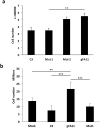Identification of p38 MAPK as a novel therapeutic target for Friedreich's ataxia
- PMID: 29568068
- PMCID: PMC5864720
- DOI: 10.1038/s41598-018-23168-x
Identification of p38 MAPK as a novel therapeutic target for Friedreich's ataxia
Abstract
Friedreich ataxia (FRDA) is an autosomal recessive neuro- and cardio-degenerative disorder caused by decreased expression of frataxin, a protein that localizes to mitochondria and is critical for iron-sulfur-cluster (ISC) assembly. There are no proven effective treatments for FRDA. We previously screened a random shRNA library and identified a synthetic shRNA (gFA11) that reverses the growth defect of FRDA cells in culture. We now report that gFA11 decreases cytokine secretion in primary FRDA fibroblasts and reverts other changes associated with cell senescence. The gene-expression profile induced by gFA11 is remarkably similar to the gene-expression profile induced by the p38 MAPK inhibitor SB203580. We found that p38 phosphorylation, indicating activation of the p38 pathway, is higher in FRDA cells than in normal control cells, and that siRNA knockdown of frataxin in normal fibroblasts also increases p38 phosphorylation. Treatment of FRDA cells with p38 inhibitors recapitulates the reversal of the slow-growth phenotype induced by clone gFA11. These data highlight the involvement of the p38 MAPK pathway in the pathogenesis of FRDA and the potential use of p38 inhibitors as a treatment for FRDA.
Conflict of interest statement
Robert B. Wilson and Yongping Wang have patents, in conjunction with the University of Pennsylvania, related to the construction and methods of use of random shRNA-expressing libraries. M. Grazia Cotticelli, Shujuan Xia, Avinash Kaur, Yongping Wang, John W. Tobias, and Robert B. Wilson have a provisional patent application, in conjunction with the University of Pennsylvania, on the use of p38 inhibitors for the treatment of FRDA; this provisional patent was licensed to FA Therapeutics LLC, in which Robert B. Wilson has a 5% equity interest.
Figures







Similar articles
-
Phenotypic Screening for Friedreich Ataxia Using Random shRNA Selection.J Biomol Screen. 2015 Oct;20(9):1084-90. doi: 10.1177/1087057115600433. Epub 2015 Aug 18. J Biomol Screen. 2015. PMID: 26286937
-
Ferroptosis as a Novel Therapeutic Target for Friedreich's Ataxia.J Pharmacol Exp Ther. 2019 Apr;369(1):47-54. doi: 10.1124/jpet.118.252759. Epub 2019 Jan 11. J Pharmacol Exp Ther. 2019. PMID: 30635474
-
Up-regulation of c-Jun N-terminal kinase pathway in Friedreich's ataxia cells.Hum Mol Genet. 2002 Nov 1;11(23):2989-96. doi: 10.1093/hmg/11.23.2989. Hum Mol Genet. 2002. PMID: 12393810
-
Mitochondrial dysfunction in friedreich's ataxia.Biol Signals Recept. 2001 May-Aug;10(3-4):263-70. doi: 10.1159/000046891. Biol Signals Recept. 2001. PMID: 11351132 Review.
-
Mitochondrial dysfunction in Friedreich's ataxia: from pathogenesis to treatment perspectives.Free Radic Res. 2002 Apr;36(4):461-6. doi: 10.1080/10715760290021324. Free Radic Res. 2002. PMID: 12069111 Review.
Cited by
-
Hyperactivation of mTOR and AKT in a cardiac hypertrophy animal model of Friedreich ataxia.Heliyon. 2022 Aug 23;8(8):e10371. doi: 10.1016/j.heliyon.2022.e10371. eCollection 2022 Aug. Heliyon. 2022. PMID: 36061025 Free PMC article.
-
Transplantation of a vascularized pedicle of hemisected spinal cord to establish spinal cord continuity after removal of a segment of the thoracic spinal cord: A proof-of-principle study in dogs.CNS Neurosci Ther. 2021 Oct;27(10):1182-1197. doi: 10.1111/cns.13696. Epub 2021 Jun 28. CNS Neurosci Ther. 2021. PMID: 34184402 Free PMC article.
-
Impact of Drosophila Models in the Study and Treatment of Friedreich's Ataxia.Int J Mol Sci. 2018 Jul 7;19(7):1989. doi: 10.3390/ijms19071989. Int J Mol Sci. 2018. PMID: 29986523 Free PMC article. Review.
-
Nuclear P38: Roles in Physiological and Pathological Processes and Regulation of Nuclear Translocation.Int J Mol Sci. 2020 Aug 24;21(17):6102. doi: 10.3390/ijms21176102. Int J Mol Sci. 2020. PMID: 32847129 Free PMC article. Review.
-
Central Nervous System Therapeutic Targets in Friedreich Ataxia.Hum Gene Ther. 2020 Dec;31(23-24):1226-1236. doi: 10.1089/hum.2020.264. Hum Gene Ther. 2020. PMID: 33238751 Free PMC article. Review.
References
Publication types
MeSH terms
Substances
LinkOut - more resources
Full Text Sources
Other Literature Sources
Medical
Research Materials

